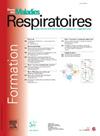In vivo and in vitro evolution of small cell lung cancer molecular subtypes under cytotoxic treatment
IF 0.5
4区 医学
Q4 RESPIRATORY SYSTEM
引用次数: 0
Abstract
Introduction
Small cell lung cancer (SCLC) is an aggressive form of lung cancer with a high mortality rate. There is currently a “one-size fit all” strategy relying on chemotherapy plus immunotherapy. The emergence of a classification of SCLC into 4 subtypes, based on the expression of transcription factors (ASCL1, NEUROD1and POU2F3 or triple negative) [1], opens the way to personalised therapeutic strategies according to subtype-specific vulnerabilities [2]. Consequently, we sought to evaluate in vitro and in vivo the evolution of subtypes under chemotherapy.
Methods
Two complementary models have been developed to test our hypothesis:
1) in vitro: exposing SCLC lines (H446 NEUROD1 + H69 ASCL1+ and H526 POU2F3 + ) to carboplatin. The evolution of subtypes has been evaluated both at protein level using western blots and RNA level using qPCR.
2) in vivo: analysing CDXs (CTC-Derived Xenografts) tumours before and after exposure to chemotherapy. Cytotoxic drugs tested were carboplatin alone (n = 4), combination of carboplatin and etoposide (n = 4) and lurbinectedin (n = 6). The expression of the different subtypes was characterised on tumours by immunohistochemical (IHC) staining using H-score.
Results
We observe a decrease of NEUROD1 protein expression after exposure of H446 cells to carboplatin. This phenotype was detectable only after 3 days of chemotherapy exposure and was independent of NEUROD1 mRNA level. Similarly, we observe a decrease of ASCL1 and POU2F3 protein expression after carboplatin treatment in H69 and H526 cells, respectively. In CDXs models, we observed a global decrease of ASCL1 expression both after lurbinectedin and carboplatin/etoposide combination in the 54.01 CDX tumors, and a strong decrease of NEUROD1expression after carboplatin in the 51.01 CDX tumors. Noticeably, POU2F3 positive cells emerge in hostpots within tumour samples after lurbinectedin treatment.
Conclusion
We demonstrate using both in vitro and in vivo models a decrease of neuro-endocrine transcription factors ASCL1 and NEUROD1 under cytotoxic-pressure. The mechanisms responsible for those changes are still to be explored. This concept of cellular plasticity modulated by chemotherapy paves the way for therapeutic sequence guided by tumour's phenotype.
细胞毒性治疗下小细胞肺癌分子亚型的体内外进化
小细胞肺癌(SCLC)是一种侵袭性肺癌,死亡率高。目前有一种“一刀切”的策略,依靠化疗加免疫治疗。基于转录因子(ASCL1、neurod1和POU2F3或三阴性)[1]的表达,将SCLC分为4种亚型的出现,为根据亚型特异性脆弱性[1]制定个性化治疗策略开辟了道路。因此,我们试图在体外和体内评估化疗下亚型的演变。方法建立了两个互补的模型来验证我们的假设:1)体外:将SCLC系(H446 NEUROD1 + H69 ASCL1+和H526 POU2F3 +)暴露于卡铂。在体内:分析化疗前后CDXs (ctc衍生异种移植物)肿瘤,在蛋白质水平上使用western blots和RNA水平上使用qpcr来评估亚型的进化。检测的细胞毒药物为卡铂单用(n = 4)、卡铂与依托泊苷联用(n = 4)和lurbinectedin (n = 6)。采用H-score免疫组化(IHC)染色表征肿瘤中不同亚型的表达。结果H446细胞暴露于卡铂后,NEUROD1蛋白表达降低。这种表型仅在化疗暴露3天后可检测到,并且与NEUROD1 mRNA水平无关。同样,我们在H69和H526细胞中分别观察到卡铂处理后ASCL1和POU2F3蛋白表达降低。在CDX模型中,我们观察到在54.01 CDX肿瘤中,lurbinectedin和卡铂/依托泊苷联合治疗后ASCL1的表达均下降,而在51.01 CDX肿瘤中,卡铂治疗后neurod1的表达明显下降。值得注意的是,在lurbinectedin治疗后,肿瘤样本中的宿主中出现了POU2F3阳性细胞。结论体外和体内模型均证实细胞毒压作用下神经内分泌转录因子ASCL1和NEUROD1的表达降低。造成这些变化的机制仍有待探索。这种由化疗调节的细胞可塑性的概念为肿瘤表型指导的治疗序列铺平了道路。
本文章由计算机程序翻译,如有差异,请以英文原文为准。
求助全文
约1分钟内获得全文
求助全文
来源期刊

Revue des maladies respiratoires
医学-呼吸系统
CiteScore
1.10
自引率
16.70%
发文量
168
审稿时长
4-8 weeks
期刊介绍:
La Revue des Maladies Respiratoires est l''organe officiel d''expression scientifique de la Société de Pneumologie de Langue Française (SPLF). Il s''agit d''un média professionnel francophone, à vocation internationale et accessible ici.
La Revue des Maladies Respiratoires est un outil de formation professionnelle post-universitaire pour l''ensemble de la communauté pneumologique francophone. Elle publie sur son site différentes variétés d''articles scientifiques concernant la Pneumologie :
- Editoriaux,
- Articles originaux,
- Revues générales,
- Articles de synthèses,
- Recommandations d''experts et textes de consensus,
- Séries thématiques,
- Cas cliniques,
- Articles « images et diagnostics »,
- Fiches techniques,
- Lettres à la rédaction.
 求助内容:
求助内容: 应助结果提醒方式:
应助结果提醒方式:


